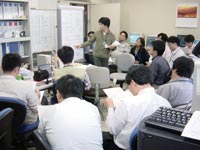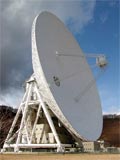 |
||||||||||

 The act of transmitting commands and receiving data to and from the Hayabusa is called an "operation." At the end of a day of operations, we hold a daily "evening meeting" to discuss the day's work. The MC of the meeting is the "supervisor" who is responsible for the week's operations. The whiteboard plays an important role as it conveniently shows the day's achievements clearly and immediately to all participants. According to the report on the day's operations, the work for the next day is discussed and determined by operators in charge of each piece of equipment and the system. This is based on fuel consumption data, the condition of data reception, and the detailed status of the explorer. All items decided upon as a result of the discussion are written on the whiteboard. You may have thought that the operation of a satellite is determined after discussing issues in a big meeting then distributing thick documents among parties concerned. However, it is more efficient to decide the next day's tasks for the explorer under operation by holding a meeting on site among the actual operators who have the latest information. In this way, there should be fewer mistakes or misunderstandings. Consequently, the whiteboard, which sounds like a "low-tech" device, is actually a convenient and important tool to share information among the team. The act of transmitting commands and receiving data to and from the Hayabusa is called an "operation." At the end of a day of operations, we hold a daily "evening meeting" to discuss the day's work. The MC of the meeting is the "supervisor" who is responsible for the week's operations. The whiteboard plays an important role as it conveniently shows the day's achievements clearly and immediately to all participants. According to the report on the day's operations, the work for the next day is discussed and determined by operators in charge of each piece of equipment and the system. This is based on fuel consumption data, the condition of data reception, and the detailed status of the explorer. All items decided upon as a result of the discussion are written on the whiteboard. You may have thought that the operation of a satellite is determined after discussing issues in a big meeting then distributing thick documents among parties concerned. However, it is more efficient to decide the next day's tasks for the explorer under operation by holding a meeting on site among the actual operators who have the latest information. In this way, there should be fewer mistakes or misunderstandings. Consequently, the whiteboard, which sounds like a "low-tech" device, is actually a convenient and important tool to share information among the team. Another story from the operation room. In space, there is no air. Without air, we do not have to worry about the weather. Thus for the Itokawa, we do not need a weather forecast, although we are still concerned about the weather.  Why? Because of the antenna located in Usuda, Nagano Prefecture. The weather there has an impact on the operation. The super large-size antenna, 64 m in diameter, cannot be operated under adverse weather conditions, thus we need a backup plan. In August, when the Hayabusa approached the Itokawa, many typhoons caused havoc in Japan. The operation team carefully monitored the forecast of typhoon movements everyday to see if the antenna in Usuda could withstand the harsh conditions. As winter approaches, we will face a different problem -- snow. The parabolic antenna, which is in a shape of a bowl, cannot function if snow builds up on it. So we will carefully watch the amount of snow fall in the Usuda district. Why? Because of the antenna located in Usuda, Nagano Prefecture. The weather there has an impact on the operation. The super large-size antenna, 64 m in diameter, cannot be operated under adverse weather conditions, thus we need a backup plan. In August, when the Hayabusa approached the Itokawa, many typhoons caused havoc in Japan. The operation team carefully monitored the forecast of typhoon movements everyday to see if the antenna in Usuda could withstand the harsh conditions. As winter approaches, we will face a different problem -- snow. The parabolic antenna, which is in a shape of a bowl, cannot function if snow builds up on it. So we will carefully watch the amount of snow fall in the Usuda district. Photo: A daily evening meeting. Photo: The Usuda Antenna. » To be continued |
|
|||||||||
|
||||||||||